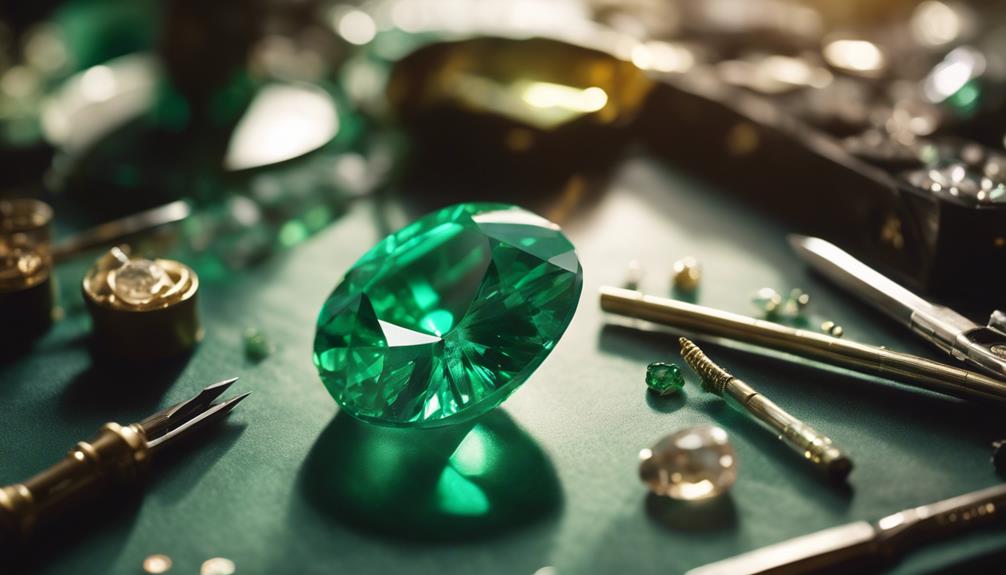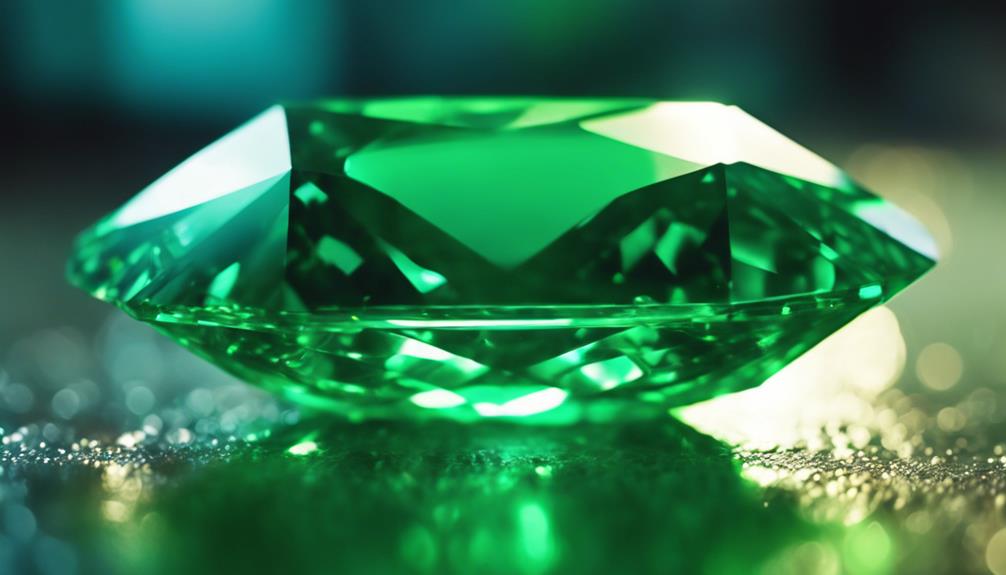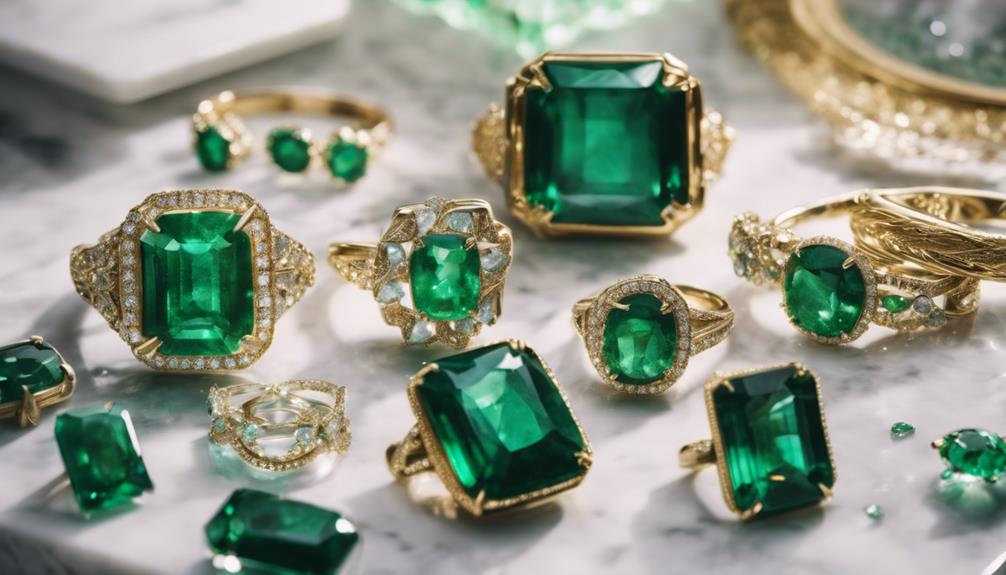When buying emerald jewelry, focus on the Four Cs: color, clarity, cut, and carat weight. Prioritize richly colored stones with minimal inclusions, as color is the most critical factor. Look for symmetrical cuts that enhance brilliance and consider overall quality over size. Verify the gemstone’s natural state, as treatments are common to improve clarity. Opt for reputable dealers who provide high-quality images, warranties, and return policies. Remember, the right emerald should appeal to your personal taste and resonate with you. Explore more tips and insights to confidently select the perfect piece of emerald jewelry.
Understanding Emeralds

Emeralds captivate with their vibrant green hues and are revered as the birthstone for May, making them a cherished choice for gifts and jewelry. Their rich color symbolizes renewal and growth, adding a touch of elegance and meaning to any piece.
Whether you’re selecting an engagement ring or a special gift, emeralds stand out for their unique beauty and significance.
In the market, emerald prices can range from a few hundred to tens of thousands of dollars. A significant price jump occurs at the 1-carat mark due to their rarity. Finding gem-quality emeralds over 1 carat is challenging, often requiring the removal of roughly five tons of dirt.
This rarity and the effort involved in mining add to their allure and value.
Emeralds are increasingly popular in the bridal market, frequently used in engagement rings either as centerpieces or accent stones. Their distinct color and properties make them a sought-after choice for those looking to make a statement with their jewelry.
Understanding these aspects guarantees you make informed decisions when purchasing emeralds, appreciating their beauty and uniqueness in the gemstone market.
The Four Cs
When evaluating emeralds, you’ll want to focus on the Four Cs: Color, Clarity, Cut, and Carat weight, with color being the most vital factor. The vibrant green hue of an emerald is its defining characteristic, and a richly colored stone will always stand out.
Clarity in emeralds is unique. Unlike diamonds, inclusions (internal flaws) are common in emeralds and are often accepted as part of their charm. These inclusions are sometimes referred to as the emerald’s ‘jardin,’ or garden, and they shouldn’t greatly detract from the stone’s beauty. However, aim to avoid inclusions that compromise the stone’s integrity.
The cut of an emerald affects its overall appearance and brilliance. A well-cut emerald will have symmetrical facets that enhance its color and sparkle. While the cut isn’t as vital as color and clarity, it still plays a considerable role in the gem’s visual appeal.
Carat weight measures the size of the emerald. Larger stones are rarer and more expensive, but it’s better to choose a smaller emerald with excellent color and clarity over a larger, lower-quality one. Always prioritize the stone’s overall quality over just its size.
Color and Clarity

Focusing on color and clarity is essential when evaluating emeralds, as these factors greatly impact the stone’s beauty and value.
When it comes to color, look for hues ranging from bluish green to pure green. The tone shouldn’t be too light or too dark; a medium to dark tone with vivid saturation is ideal. High saturation levels often lead to higher value, but remember that a well-saturated light-toned emerald can be equally stunning.
Clarity in emeralds is unique. Unlike other gemstones, inclusions are common and expected in emeralds, giving each stone character. These inclusions, often called ‘jardin,’ resemble natural patterns and can enhance the stone’s beauty. However, avoid inclusions that look like bubbles or are arranged in a way that detracts from the gem’s appearance. Deep inclusions might pose a risk of fractures, so examine the stone carefully.
Treatments with oils or resins are standard to improve emerald clarity. Make sure you’re aware of any such treatments and verify the stone’s natural state.
Understanding these nuances will help you select an emerald that’s not only beautiful but also a valuable addition to your jewelry collection.
Buying Tips
To guarantee you make a well-informed purchase, start by researching reputable dealers known for their transparency and quality. Companies like Leibish & Co. and James Allen are good examples. Always check for high-quality images and videos of the emeralds you’re interested in. This lets you see the stone’s true color, clarity, and overall appeal.
Prioritize visual appeal over investment value. Choose an emerald that resonates with you personally, focusing on its beauty and how it makes you feel. Remember the key quality factors: cut, color, clarity, and carat weight. Smaller stones with excellent color often outshine larger, poorer-quality ones.
Ensure the seller offers warranties and return policies. This adds a layer of security to your purchase, giving you peace of mind. Compare prices across different platforms to find the best deal. Don’t rush; take your time to make a thoughtful decision.
Lastly, don’t hesitate to seek expert advice. Gemstone buying can be complex, and professional guidance can help you avoid common pitfalls. By following these tips, you’ll be well-equipped to choose the perfect emerald jewelry.
Additional Resources

Explore detailed guides on various gemstones like sapphires and rubies to broaden your knowledge and make more informed decisions. Understanding the nuances of different stones can help you appreciate the unique qualities of emeralds.
Additionally, you’ll find resources comparing natural and cultured pearls valuable, especially if you’re considering adding more variety to your jewelry collection.
For those interested in engagement rings, look into specific guides on moonstone and peridot rings. These resources can provide insights into their unique properties and how they compare to emeralds. Also, reviewing tips on the best places to buy engagement rings online can save you both time and money.
Expert resources are essential for personalized buying advice. Websites like the Gemological Institute of America (GIA) offer extensive information on gemstones, including emeralds. They provide certification and authenticity checks, which are vital for making a trustworthy purchase.
Lastly, consider forums and community groups dedicated to gemstones. Engaging with seasoned collectors and buyers can offer practical advice and firsthand experiences. Forums often have discussions about reputable sellers, market trends, and care tips, making them a treasure trove of information for any gemstone enthusiast.
Conclusion
By understanding emeralds and the Four Cs, you’ve gained the essential knowledge to make a confident purchase.
Remember, color is key, and inclusions can add unique charm.
Always buy from reputable dealers and use expert tips to guide your choice.
With this wisdom, you’ll select an emerald that’s not only stunning but also a valuable investment.
Enjoy the journey of finding that perfect piece of emerald jewelry!



